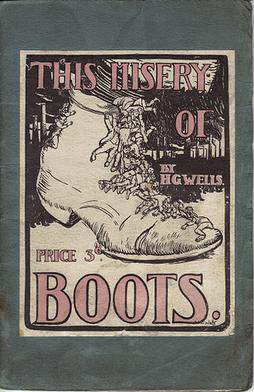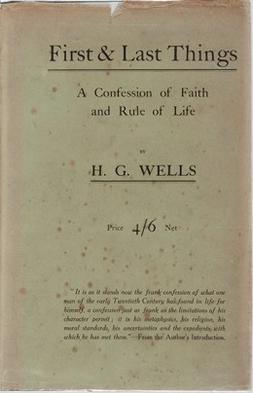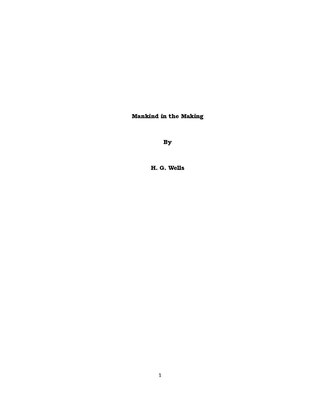
The Outline of History, subtitled either "The Whole Story of Man" or "Being a Plain History of Life and Mankind", is a work by H. G. Wells chronicling the history of the world from the origin of the Earth to the First World War. It appeared in an illustrated version of 24 fortnightly installments beginning on 22 November 1919 and was published as a single volume in 1920. It sold more than two million copies, was translated into many languages, and had a considerable impact on the teaching of history in institutions of higher education. Wells modelled the Outline on the Encyclopédie of Denis Diderot.

Russia in the Shadows is a book by H. G. Wells published early in 1921, which includes a series of articles previously printed in The Sunday Express in connection with Wells's second visit to Russia in September and October 1920. Wells was at the height of his fame, having recently completed The Outline of History, and was paid £1000 for the articles by the Sunday Express. During his visit to Russia he visited his old friend Maxim Gorky, whom he had first met in 1906 on a trip to the United States, and who arranged Wells's meeting with Lenin.

A Modern Utopia is a 1905 novel by H. G. Wells.

This Misery of Boots is a 1907 political tract by H. G. Wells advocating socialism. Published by the Fabian Society, This Misery of Boots is the expansion of a 1905 essay with the same name. Its five chapters condemn private property in land and means of production and calls for their expropriation by the state "not for profit, but for service."

Mr. Britling Sees It Through is H.G. Wells's "masterpiece of the wartime experience in south eastern England." The novel was published in September 1916.

The World of William Clissold is a 1926 novel by H. G. Wells published initially in three volumes. The first volume was published in September to coincide with Wells's sixtieth birthday, and the second and third volumes followed at monthly intervals.

The Story of a Great Schoolmaster is a 1924 biography of Frederick William Sanderson (1857–1922) by H. G. Wells. It is the only biography Wells wrote. Sanderson was a personal friend, having met Wells in 1914 when his sons George Philip ('Gip'), born in 1901, and Frank Richard, born in 1903, became pupils at Oundle School, of which Sanderson was headmaster from 1892 to 1922. After Sanderson died, while giving a lecture at University College London, at which he was introduced by Wells, the famous author agreed to help produce a biography to raise money for the school. But in December 1922, after disagreements emerged with Sanderson's widow about his approach to the subject, Wells withdrew from the official biography and published his own work separately.

First and Last Things is a 1908 work of philosophy by H. G. Wells setting forth his beliefs in four "books" entitled "Metaphysics," "Of Belief," "Of General Conduct," and "Some Personal Things." Parts of the book were published in the Independent Magazine in July and August 1908. Wells revised the book extensively in 1917, in response to his religious conversion, but later published a further revision in 1929 that restored much of the book to its earlier form. Its main intellectual influences are Darwinism and certain German thinkers Wells had read, such as August Weismann. The pragmatism of William James, who had become a friend of Wells, was also an influence.

The Discovery of the Future is a 1902 philosophical lecture by H. G. Wells that argues for the knowability of the future. It was originally delivered to the Royal Institution on January 24, 1902. Before appearing in book form, it was published by Richard Gregory in Nature on February 6, 1902, and was also published as part of the Annual Report of the Smithsonian Institution. Available online.

The Passionate Friends is a 1913 coming of age novel by H. G. Wells detailing the life and travels of a young man. It is notable as the first introduction of Wells's notion of an "open conspiracy" of individuals to achieve a world state.
The Wife of Sir Isaac Harman is a 1914 novel by H. G. Wells.

An Englishman Looks at the World is a 1914 essay collection by H. G. Wells containing journalistic pieces written between 1909 and 1914. The book consists of twenty-six pieces ranging from five to sixty-two pages in length. An American edition was published the same year by Harper and Brothers under the title Social Forces in England and America.

Bealby: A Holiday is a 1915 comic novel by H. G. Wells.

A Year of Prophesying collects 55 newspaper columns written by H. G. Wells in 1923 and 1924.

The Work, Wealth and Happiness of Mankind by H. G. Wells is the final work of a trilogy of which the first volumes were The Outline of History (1919–1920) and The Science of Life (1929). Wells conceived of the three parts of his trilogy as, respectively, "a survey of history, of the science of life, and of existing conditions." Intended as an unprecedented "picture of all mankind to-day" in all its manifold activities, he called it "the least finished work . . . because it is the most novel." He hoped the volumes would play a role in the open conspiracy to establish a progressive world government that he had been promoting since the mid-1920s.

All Aboard for Ararat is a 1940 allegorical novella by H. G. Wells that tells a modernized version of the story of Noah and the Flood. Wells was 74 when it was published, and it is the last of his utopian writings.

Joan and Peter, a 1918 novel by H. G. Wells, is at once a satirical portrait of late-Victorian and Edwardian England, a critique of the English educational system on the eve of World War I, a study of the impact of that war on English society, and a general reflection on the purposes of education. Wells regarded it as "one of the most ambitious" of his novels.

Anticipations of the Reaction of Mechanical and Scientific Progress upon Human Life and Thought, generally known as Anticipations, was written by H.G. Wells at the age of 34. He later called the book, which became a bestseller, "the keystone to the main arch of my work." His most recent biographer, however, calls the volume "both the starting point and the lowest point in Wells's career as a social thinker."

Mankind in the Making (1903) is H.G. Wells's sequel to Anticipations (1901). Mankind in the Making analyzes the "process" of "man's making," i.e. "the great complex of circumstances which mould the vague possibilities of the average child into the reality of the citizen of the modern state." Taking an aggressive tone in criticizing many aspects of contemporary institutions, Wells proposed a doctrine he called "New Republicanism," which "tests all things by their effect upon the evolution of man."

H. G. Wells (1866–1946) was a prolific English writer in many genres, including the novel, history, politics, and social commentary, and textbooks and rules for war games. Wells called his political views socialist.



















